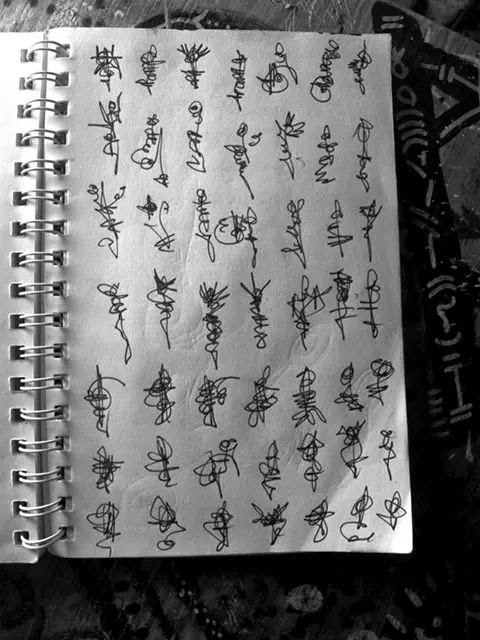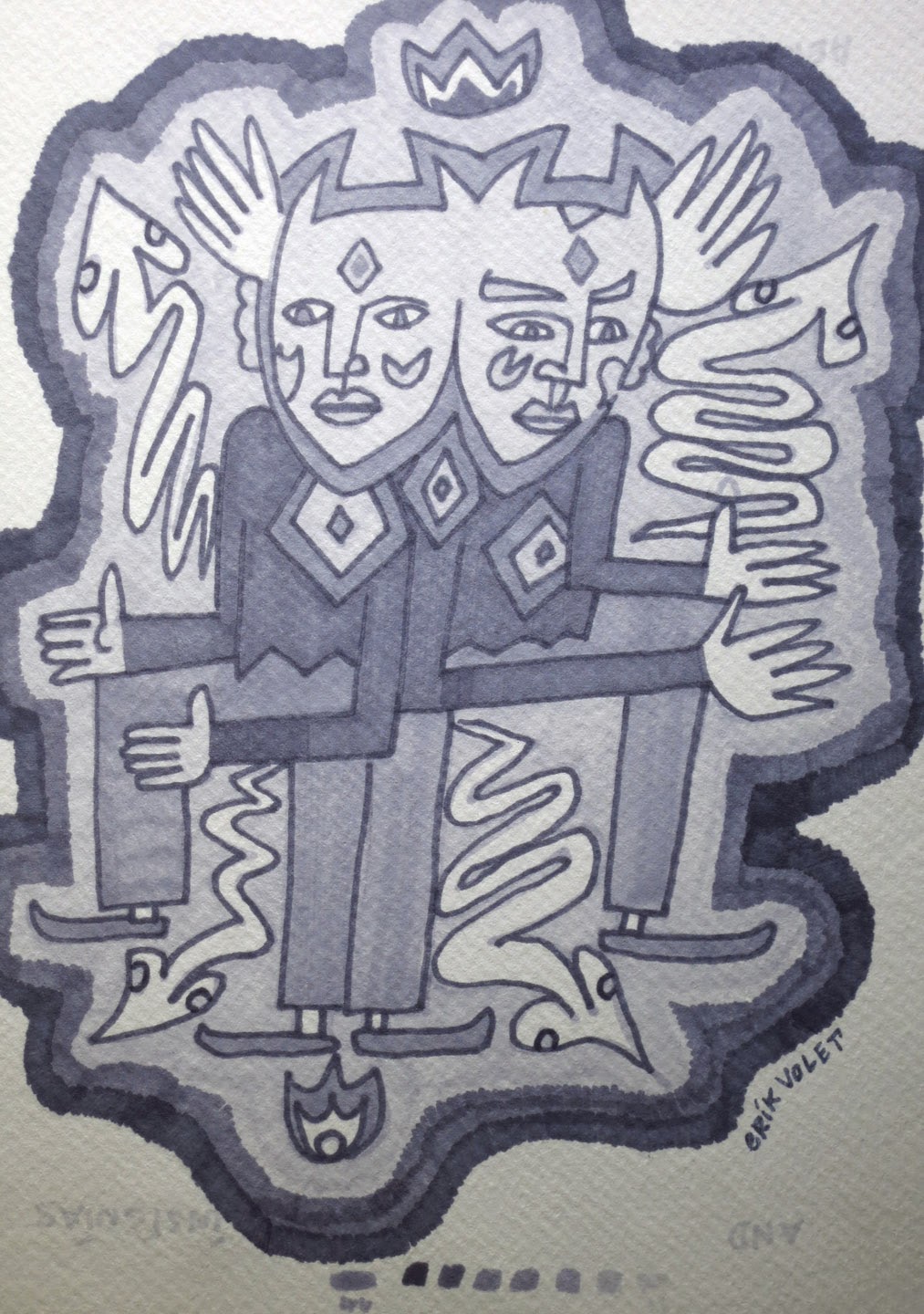Bright and chipper, eager to chat
about the intersections of jazz and hip hop,
about the intersections of jazz and hip hop,
Brownman Ali calls me on a Sunday afternoon
between an eleven am big band rehearsal
and an early evening studio pre-production session.
The Trinidad-born, Brooklyn-bred, Toronto-based
between an eleven am big band rehearsal
and an early evening studio pre-production session.
The Trinidad-born, Brooklyn-bred, Toronto-based
trumpeter, composer, teacher and bandleader is a man of boundless energy;
juggling juggernaut jams in a menagerie of musical settings.
The previous night, at Melodia in Burlington.
Brownman presented a condensed version
of his annual 5 week Miles Davis tribute.
Brownman:
The first step is to make a set list
that speaks to his career, and that's hard.
We did our first set in suits,
covering the bop and swing stuff: the Acoustic era of 47-68.
After (that) we took a set break;
we actually made a costume change,
came back psychedelic, with sunglasses and headbands.
It changes the vibe, it changes how you approach the music.
Brownman presented a condensed version
of his annual 5 week Miles Davis tribute.
Brownman:
The first step is to make a set list
that speaks to his career, and that's hard.
We did our first set in suits,
covering the bop and swing stuff: the Acoustic era of 47-68.
After (that) we took a set break;
we actually made a costume change,
came back psychedelic, with sunglasses and headbands.
It changes the vibe, it changes how you approach the music.
To spend the whole night inside Miles' head
is a real heavy thing, for all of us...
You need five heavy musicians who are versatile enough.
There's literally only about three bassists in Canada that could play this gig.
is a real heavy thing, for all of us...
You need five heavy musicians who are versatile enough.
There's literally only about three bassists in Canada that could play this gig.
Marc Rogers of course tops that list.
Also joining Brownman on this sold-out gig were
Andy Ballantyne on alto, tenor, and soprano sax,
Adrean Farrugia on piano and keyoards,
and Anthony Michelli on drums
We had to sublimate our own voices musically to play the idiom.
It was interesting to watch the transition...
slowly watch it morph by the end of the night into me.
By the end of their second set,
the quintet were riffing in an idiom four decades removed
from where they began: Miles' work from the 80's, which was
distinguished by crisp beats and Marcus Miller's tight slap-bass:
something much closer to Gruvasylum's sound:
Also joining Brownman on this sold-out gig were
Andy Ballantyne on alto, tenor, and soprano sax,
Adrean Farrugia on piano and keyoards,
and Anthony Michelli on drums
We had to sublimate our own voices musically to play the idiom.
It was interesting to watch the transition...
slowly watch it morph by the end of the night into me.
(photo Nils Blondon)
the quintet were riffing in an idiom four decades removed
from where they began: Miles' work from the 80's, which was
distinguished by crisp beats and Marcus Miller's tight slap-bass:
something much closer to Gruvasylum's sound:
Brownman's own brand of high-energy electric funk.
Cats like Guru and Miles, they're always looking to the future:
Guru is the Miles of hip hop.
The years I had with him were life changing:
I know all his ethics, I know his ideologies.
The only difference is, he was a hip hop artist coming at the jazz idiom
and I was a jazz artist coming at the hip hop genre from a jazz perspective.
and I was a jazz artist coming at the hip hop genre from a jazz perspective.
And really, it's not that different from what Miles does.
What defined Miles?
Three things: courage, irreverence, and evolution.
Miles was not interested in playing the music of yesterday,
and that's the thing with hip hop;
look at some of these guys from the Golden Era:
still touring around the same old tired record.
What defined Miles?
Three things: courage, irreverence, and evolution.
Miles was not interested in playing the music of yesterday,
and that's the thing with hip hop;
look at some of these guys from the Golden Era:
still touring around the same old tired record.
and was asked to play with the band Type Relevant in upstate New York.
Mad Dukez was their rapper, that's how we met. I was blown away:
I was so knocked out by his flow;
his sense of timing, his sense of rhythm,
and by his sense of storytelling.
The freestyle form in hip hop
is not so different from the jazz solo:
the headspaces are similar, the context is similar.
Gruvasylum investigates that connection.
I asked Brownman what his thoughts and plans were;
going into the studio this week to record
Gruvasylums second album
Mad Dukez is coming up from New York tomorrow.
I have all of these pre-production ideas;
and a lot of them are quite loose,
which is very different from when I go in with other groups,
say ELECTRYC TRIO or CRUZAO.
I'm going into the studio tonight:
I've got a couple snippets, just frameworks,
grooves for bass, drums, and keyboards.
I've played them, sampled them, looped them.
Then I'll bring in Dukez, (and) talk about the ethics,
the idea of the tune. I'm setting the parameters,
but its gonna be Dukez doing the storytelling
There's a track on my Juggernaut album;
Evolution Revolution, that came about because
Guru would say 'the evolution of hip hop
need(ed) a revolution'.
'Cause conceptually a lot of hip hop today
is about rims, helicopters, and bravado,
(That's) not using your form.
I think that's whack.

The ethic of Gruvasylum
is to deal with real subject matter,
even if its just a story about a girl.
Coming up in Brooklyn, we would sit on the stoop
and just tell tales: go through a day of your life
or a big story arc: that's a Brooklyn tradition.
We're trying to get back to that act of authentic storytelling
and maybe have a certain literary bent to it.
differs from the rest of his projects:
his foray into hip hop takes aim
at street poetry's full potential
for engaged storytelling,
the vitality of the oral tradition,
and relevance:

Mad Dukez, Fresh Kils on the set of their Sookie Sookie video shoot
is to deal with real subject matter,
even if its just a story about a girl.
Coming up in Brooklyn, we would sit on the stoop
and just tell tales: go through a day of your life
or a big story arc: that's a Brooklyn tradition.
We're trying to get back to that act of authentic storytelling
and maybe have a certain literary bent to it.
That's harder to find now
than it was in the Golden Era, y'know:
than it was in the Golden Era, y'know:
guys like KRS ONE and Public Enemy.
Brownman's vision for GRUVASYLUMdiffers from the rest of his projects:
his foray into hip hop takes aim
at street poetry's full potential
for engaged storytelling,
the vitality of the oral tradition,
and relevance:
I'm hoping the beats will remind people of late Miles
or early hip hop.
What do with my different groups (is)
I break up all of my interests
and I have a different ensemble for each interest
and I really focus on the one thing.
or early hip hop.
What do with my different groups (is)
I break up all of my interests
and I have a different ensemble for each interest
and I really focus on the one thing.
Holding down the gruve for Brownman and Dukez this friday
will be BEN MILLER on 6-string electric bass
and GEOFF BRUCE on drums
For all Friday Nov. 28th GRUVASYLUM Toronto show info:
will be BEN MILLER on 6-string electric bass
and GEOFF BRUCE on drums
For all Friday Nov. 28th GRUVASYLUM Toronto show info:
The band is also playing DBGB's
in Buffalo on Sat. Nov. 29th
For all Buffalo show info













.jpg)
.jpg)


.jpg)












